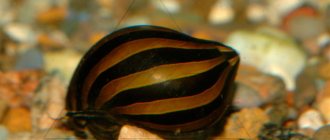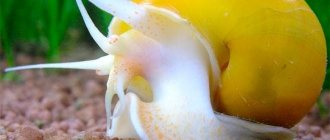The ampularia snail, the photo of which is now in front of you, comes from the Amazon. In the modern world of aquariums, this bright and large creature is becoming increasingly popular. Nowadays, the big yellow snail is known to every lover of glass houses for aquatic inhabitants.
The apple snail family consists of tropical freshwater snails, some varieties are suitable for keeping in private ponds and aquariums. This amazing creature is rightfully considered the orderly of the aquatic world. In addition, ampularia snails look very beautiful in an aquarium; their reproduction in captivity is simple, and as for keeping and feeding them at home, there are no difficulties in these matters either. You just need to study some of the features of their life, and everything will be fine. You will learn how to care for these bright, beautiful snails by reading the article; we will also reveal secrets on how to reproduce them at home.
Ampularia snail: photo, description
Yellow representatives of this species are the most common, but this is far from the only color of these aquarium creatures. The snail can be white, black or brown. Blue snails look very unusual; they are considered the most fashionable. Whatever color is on the “house” of this underwater orderly, maintenance and feeding are the same for everyone.
When you buy a snail, you see a small creature in front of you, which is about 2.5 cm in diameter. This is the size that is recommended for purchase. Only when purchasing this aquatic miracle, many forget or simply cannot imagine that a beautiful little thing can grow up to 9-10 cm. Individuals are known that have reached even larger sizes, this is facilitated by increased feeding and a spacious aquarium.
Description of ampularia
What are these exotic pets? Ampullaria aquarium snails come from the Amazon River. In nature, they are found in the tropics. They are comfortable living in such a climate. Snails spend most of their time in water, but they also need land. They come ashore to get some air or lay eggs. During drought, the ampularia hides in the shell and is closed with a horny lid so that unfavorable conditions do not disturb it. She acts the same way when she is in danger.
There are several colors of these aquarium snails. The most popular is yellow. You can also find brown, white, black and even blue individuals. Care and maintenance will be the same for snails of all existing colors.
The main feature of these pets is their size. They are very large. Well-nourished and healthy apple apples can grow up to 8-10cm, although they may barely measure 3cm at the time of purchase.
How long do snails live? Life expectancy and behavior depend on water temperature. The lower it is, the longer the pets' life will be. At +20°C they will be more active and live for 2 years. At +30°C they will become sluggish and die within 1 year.
How to keep aquarium snails
The ampularia snail, the maintenance of which is quite simple, can live in a relatively small aquarium, but this is provided that there is only one such pet. In this case, a forty-liter glass house will be enough. But usually such animals are not kept alone; if 3-4 individuals live together, and there are also fish with them, then they will need an aquarium of one hundred liters.
If you already have adult aquarium ampularia snails, the owner must keep their reproduction under control, otherwise he will soon have a countless number of them. Experts recommend allocating about 11-12 liters for one yellow beauty. It is also necessary to ensure that dead ampullaria snails are not left to decompose in the aquarium; the behavior before the death of these creatures is that they freeze, their body completely relaxes, they hardly move.
Peculiarities of ampularia reproduction
Unlike other species of cephalopods, ampullaria are not hermaphrodites, and for their successful breeding it is necessary to have a male and a female. The problem is that it is visually impossible to distinguish a male from a female - they are extremely similar.
Find out more about breeding ampullaria in your home aquarium.
If an aquarist seriously sets out to replenish the ampularia population, then at least a dozen individuals of this species should live together in the aquarium. In this case, there is always hope that there will be at least one opposite-sex couple among them.
Courtship, the process during which male and female snails attract each other's attention before mating, lasts from 2 to 12 hours.
Do not pour water into the container with ampoules to the edge; you need to leave a 7-centimeter air gap between the water surface and the lid. This condition must be observed, since the mother ampularia spawns on the dry glass wall of the tank.
Video: reproduction of ampularia Sometimes you can see eggs attached even to the bottom of the aquarium lid. Ampullaria lay eggs at night; the older it gets, the darker the color of the masonry will be. The babies will begin hatching in 3 weeks: yellow, brown or blue small snails will appear.
Important! Ampoules do not need stimulation in matters of reproduction. Mating will begin as soon as the gastropods become sexually mature - after they reach the age of one year. The aquarist can only put them in the tank and wait.
Aquarium water
Keeping and breeding at home is also simplified by the fact that ampularia snails are completely undemanding to water; reproduction of these beauties is possible in conditions much worse than what is acceptable for other aquatic inhabitants, especially fish. The owner of the aquarium only needs to follow the rules of filtration and water replacement.
The snail's house requires special attention. In order for it not to be destroyed, but, on the contrary, to be renewed and built, calcium is needed. If the water in the aquarium is too soft, then you need to add limestone, small marble, and shells from the sea. It is even easier to restore calcium deficiency by simply purchasing a special preparation at the pet store designed to increase water hardness.
Content Rules
Despite their unpretentiousness, aquarium snails have their own “requirements” for their habitat. Providing them with the most comfortable living conditions will not be difficult if you adhere to the following rules:
- if you want to grow large, beautiful mollusks, then you need to calculate the volume of water to maintain them: each individual will need 15 liters;
- the aquarium must have a lid, otherwise pets may simply escape from it, fall to the floor and break;
- There must be free space between the lid and the surface of the water where the snails can breathe air.
Of course, if the aquarium is inhabited by fish, then it is equipped with a filter. For ampularia, clean water is also very important. Therefore, the filter element must be washed regularly.
Aquarium water
Keeping ampullaria snails in an aquarium requires the owner to pay special attention to the water. It should be moderately hard. In too soft water, the shells of mollusks will not be strong and may collapse.
It is important to create an optimal temperature regime. The temperature should be between 20-27 degrees. In colder temperatures, the snails will simply freeze, and when the water temperature is higher, the lifespan of the ampullaria is shortened.
Ampoule nutrition
These mollusks are very gluttonous, but have no special food preferences. Most often, they simply eat up the food that sank to the bottom after feeding the fish, thereby cleaning the soil.
Any diet intended for fish will suit snails. They will also happily eat bloodworms, which are a source of protein. You can diversify your diet with boiled vegetables, chicken and herbs.
It is very important that the snails are well-fed to prevent the risk of them eating the aquarium plants.
Care
Ampoules do not require special care. However, due to their gluttony, they leave a lot of waste in the aquarium. Therefore, if the number of mollusks is large enough, you need to install a more powerful filter, as well as a compressor for additional aeration.
To prevent damage to the snails' bodies, do not use fine soil made from pebbles with sharp edges. It is better to put sand or pebbles on the bottom.
Ampoule care
The ampularia snail is very easy to care for; even a primary school student can be trusted to maintain it. To maintain an average temperature in the aquarium, a lamp is successfully used to heat the water. If the snails get cold or they just want to bask in the warmth, they gather on the wall on the side where the light warms.
The aquarium must be covered with a lid, otherwise, if your “horned” pets don’t like something in their home, they will simply crawl out of there and go for a walk. In this case, you need to find out what prompted them to escape and eliminate the inconvenience. For fugitives, if you carefully examine the places near the aquarium, you will immediately discover that they are not able to crawl far.
From time to time, the ampularia snail crawls out to take a breath of air; to do this, there should be free space between the edge of the water surface and the lid of the aquarium. It is interesting to watch the tricks of the yellow beauties, as they look very funny, especially when they do it together, several individuals at a time. First, the snail, filled with air, floats up, then exhales, then falls to the bottom with a loud gurgle. Some newcomers to snail breeding, seeing such actions of their pets for the first time, get scared, thinking that the poor creatures have breathed their last and fallen to the bottom dead. This, of course, is not the case, everything is fine with the “stags” - they took a breath of air and immediately rested.
Feeding
Proper care and regular quality nutrition are important for the health of your pet. It is important to consider that the ampoule feeds on what falls on the ground. If there are also fish in the aquarium, the food may not reach the bottom. Receiving less food, the snail will begin to destroy the algae. For this reason, food that floats on the surface is not suitable.
Try not to overfeed your pets
How to feed ampoule? First of all, you need to take food that sinks immediately to the bottom. The one that fish don’t eat will also work. For example, vegetables.
You can’t just pour in more food, because the rest of the underwater inhabitants can still eat all the food during feeding, and this will lead to obesity and disease, because the fish cannot be overfed.
You can add zebrafish to the ampularia, which will only eat food from the surface of the water. Then the one that falls to the bottom will go to the snails.
What to feed ampullaria snails? They will happily eat almost any food. Suitable food for fish or catfish. You can give them vegetables, but you need to boil them first. Zucchini, pumpkins and even cucumbers will do. It is necessary to ensure that vegetables are not left in the aquarium for more than a day. They should be removed, otherwise the water will become cloudy. For more details, watch this video:
For this reason, you should not give ampullaria too much food at one time. If they don't have time to eat it, it will spoil the water. You can feed the snails bloodworms or tubifex. It is important that the diet includes vegetables, otherwise all the plants in the aquarium will be destroyed.
Diet
Now let's talk about what ampullaria snails eat. This question is the easiest, since the beautiful creatures are literally omnivores. Horned creatures can eat anything that they can swallow or grind. Food must be given in such quantities that the snails are able to eat it. It is almost impossible to overfeed the aquatic beauties, but if you give too much food, you will pollute your aquarium. In no case should these large snails go hungry; they are larger than their other brethren, and require increased nutrition for normal existence. It often happens that the owners of huge aquariums have ampullaria dying from hunger and exhaustion for the simple reason that these slow animals in a large group of nimble fish were not able to get food for themselves. They did not have enough food that was given by the careless owner of the fish kingdom.
In order for the handsome “horned” one to grow and develop normally, you need to know what he likes to eat and what to feed the ampoule snails so that they eat their fill. In addition to the fact that they happily eat algae and fish food, or rather, what remains of it after a feast of more mobile aquatic inhabitants, snails eat dead fish and other dead organic matter. That’s why they are called aquarium orderlies; they cleanse their home of pollution, even cleaning the walls of the glass “palace.” The yellow beauties with houses on their backs also love to eat spinach, cucumbers, carrots, and lettuce. The favorite delicacy of the “horned ones” is banana peels, which are already slightly rotten. Only soft food is suitable for snails; they are not adapted to eat hard food.
Care and maintenance of ampoule
Keeping the ampularia snail with other inhabitants of the aquarium is fraught with negative consequences specifically for the mollusks. Some fish can cause inconvenience to ampullaria.
Some of them brazenly tear off their antennae, while others can even eat an entire adult snail. They pose a mortal danger to eggs and small baby ampullaria. There is another misleading opinion that it is ampullaria that pose a danger to fish. In fact, this is far from true and these mollusks are absolutely harmless.
In the photo there is a blue ampularia
This myth arose because sometimes there are cases of snails eating dead fish. Ampullaria simply do not have the strength or energy to hunt the living, much less eat them.
It is not advisable to place these snails in an aquarium with beautiful and expensive plants; they eat them with pleasure. But there is still a way out of the situation. It is necessary to place the ampullaria next to hard algae; they will remain intact because the mollusks are too tough for this.
For these aquarium inhabitants, the quality of the water is completely unimportant. The main thing is that it is not too soft. Such water causes rapid destruction of their shell. The appearance of small pits or ulcers on them indicates that destruction is beginning.
The water in an aquarium with ampoule must be filtered, aerated and replaced regularly. The average temperature of the water in which these tropical inhabitants are cozy and comfortable is about 24 degrees.
The most ordinary small aquarium with a volume of 10 liters is suitable for them. The reproduction of these snails occurs with amazing speed. They eat a lot, and therefore leave behind a large amount of waste.
They don't have any special food preferences. Even a novice aquarist knows what to feed ampularia snails All types of food are suitable for them. Ampoules love vegetables - carrots, cabbage, lettuce, zucchini and cucumbers.
They just need to be initially treated with boiling water to make them a little softer. It is better to remove the remaining vegetables from the aquarium, otherwise it will quickly become clogged. These mollusks also love live food. They happily eat bloodworms and tubifex.
Lifestyle
The ampularia snail comes from the tropics, its body is designed to survive in just such a climate. For example, during drought, these creatures survive thanks to their well-developed muscular leg and the protective flap on it. With this flap, like a small door, the snail closes its “house” and waits out a long dry period, remaining alive even in the mud or in puddles left over from dried up reservoirs.
Another feature of snails is their respiratory system. They have gills on the right side and lungs on the left. In an aquarium, ampularia rise to the surface of the water and, using a breathing tube, pump oxygen reserves into themselves.
The horned, colorful creatures with beautiful shells on their backs have very few activities in their lives; by nature, they are quite lazy. They have only one job - to continue their race by reproducing. When the ampularia snail has laid eggs, what should it do after that? Naturally, you need to eat. This is how these aquatic inhabitants exist - they breed and eat, and they can also sleep, tired of such important matters.
Aquarium snails do not hibernate; they have no need for it. Unless the water in their glass house is too cold, but even in this case they will only become slower, as if sleepy, and will not hibernate, like their relatives from the wild.
Aquarium mates
At first glance, it may seem to uninformed people that giant yellow snails, suitable for a home aquarium, are capable of harming their graceful neighbors - fish. Indeed, they are much larger than most species of aquarium inhabitants. This opinion is especially strengthened after a person sees a huge snail happily gobbling up a dead, unfortunate fish. But in fact, if you think a little, it will become clear that such a slow creature as the ampullaria snail cannot catch up with the nimble, evasive fish. Everything is explained simply, snails are ordinary scavengers. The fish that this useful creature for the aquarium eats was already dead before it became lunch for the aquatic orderly.
If you look from the other side, these fish often offend and harm peaceful and calm snails. They bite off their antennae-horns, and some especially aggressive ones eat small individuals and harm the health of large ones. In addition to fish, the enemies of ampullaria are crayfish and shrimp, which can easily get a snail out of its shelter house and eat it. For this reason, it is not recommended to place the following types of fish in the same aquarium with them:
• Sumatran barbs; • tetradon dwarf; • green tetradon; • fahaka; • botia clown; • large cichlids.
Aquarium ampullaria snails: reproduction
Even in sexually mature ampullaria, only an experienced specialist can tell where the male is and where the female is. It is easier to place 4-5 snails in your aquarium at once; usually in such a company there will definitely be individuals of different sexes. Ampullaria snail eggs can be found on the inner wall of the fish “house”, above the surface of the water, or on the glass that covers the top of the aquarium. A large yellow snail can have several hundred eggs.
At first, when the female lays eggs, her eggs are almost pure white with a yellow tint. Over time, the eggs become harder and become off-white in color. The expectant mother most often lays eggs just before sunrise in a place that was heated by backlight lamps during the day. Because of this, when the owner turns on the backlight in the morning, the newly made masonry dies from the heat. If you need to keep the eggs intact and if you want to wait for the offspring of the snails, the eggs must immediately be cut off the glass and placed on a special floating object, for example, a piece of polystyrene foam or even ordinary seaweed.
Reproduction and lifespan of the ampularia snail
Most of the snails are hermaphrodites. These mollusks are an exception. They are of different sexes, but one cannot tell them apart. How ampullaria snails reproduce has been known for a long time.
This requires two people. Therefore, if you decide to buy ampularia snails, it is best to buy 3-4 individuals. In order for them to mate, you do not need to resort to any stimulation methods.
Everything happens on a natural level. After mating is completed, the snail begins to look for a convenient place to lay eggs. Most often she does this in the spring.
Under no circumstances is it advisable to move ampullaria snail eggs. After about a month, small snails emerge from the eggs . It is not advisable to leave them in a community aquarium.
The fry may die from their insatiable fish neighbors. From the first day of their birth, snails are able to feed on their own. Beginner aquatic hobbyists are often interested in the same question: how long do ampoule snails live? There is no clear answer to this question. It all depends on the type of snail, its habitat and many other factors. Their average lifespan is from 1 to 4 years.
Small ampularia
Depending on the temperature, the first snails appear 2-4 weeks after laying eggs. The masonry itself becomes noticeably darker during this period, the babies diligently gnaw their way to the light and, having finally cleared the path, fall into the water. At this moment, newborn ampularia may die, becoming a snack for the inhabitants of the aquarium. To maintain such a large replenishment, you need to place the babies in another container with water. It will be even easier to transfer the entire clutch of eggs to the spawning aquarium from the very beginning. Anyone who has ever caught small ampularia in water knows how difficult it is.
Immediately after birth, the snails begin to eat algae and softened fish food. After just 14-16 days, the babies eat everything that their adult parents eat.
Lifespan
The lifespan of ampularia depends on the temperature of the water in the aquarium and the conditions of detention. If a snail grows and develops at a relatively low temperature, it can live up to three years. If the thermometer shows 25 degrees or higher, then she is destined to live half as long - 12-17 months. Although in warm weather, the yellow beauties grow very quickly, mature and reproduce.
Experts recommend maintaining the temperature for snails within 19-25 degrees. So these creatures cannot live in a home pond all year round, except that in the warm summer they will delight their owners with the bright color of their shells.
Maintenance and care
Ampularia snails are quite peaceful creatures. They never bother fish or invertebrates, which, on the contrary, can be dangerous for them. For example, shrimp or crayfish often pick out shellfish from shells and eat them, and large fish (cichlids, etc.) nibble on them whenever possible.
Ampoules do not pose a danger to any aquarium inhabitants
In small aquariums you should not keep too many shellfish , as they will not have enough food and space. One snail needs approximately 10 liters of volume. Ampoules feel comfortable when the water temperature is 24 degrees and above. It is also advisable to install a filter in the aquarium that will purify the water, because these individuals eat a lot and, therefore, a large amount of waste products remains from them.
It is also very important that there is enough calcium in the water. If there is not enough of it, then the shell of these peaceful creatures will begin to collapse.
If the water is soft, then you can add a special preparation to it, which is sold in a pet store, or put limestone and sea shells in the aquarium.
What do snails get sick of?
In order to ensure a normal existence for their aquarium pets, the owner must know the possible diseases of ampullaria snails. It often happens that yellow beauties have their main decoration - their shell - destroyed. It happens that, due to an oversight, there is not enough calcium in the water, and therefore there is simply nothing for the snails to form their “house” from. The result will be disastrous, in the form of a cracked and deformed shell. If you notice such a problem in time and add the required amount of calcium to the water, the yellow snails will “repair” their shelter by patching up the holes that have formed.
Another problem with snails is mites, which can cause damage to shells by forming depressions in them. To get rid of such uninvited guests, it is necessary to remove one snail from the water and treat them with a special product containing formaldehyde. Before treatment, dry the sink with cotton wool. This procedure must be carried out very quickly so that the ampoule does not suffer from prolonged exposure to air.
If an unsightly green coating appears on the snail’s “house,” you can simply remove it with a regular toothbrush. After wiping the sink several times, you will get its original bright and beautiful color.
Interesting facts about snails
The ampullaria snail is a very interesting and not fully studied creation of nature; here are some interesting facts from its life presented to your attention:
• Ampullaries are completely deaf. Scientists have proven their complete deafness. • Snails' vision is very poor; they can only distinguish light from dark.
• Regeneration allows snails to regrow a lost organ within 20-25 days, even the eyes are no exception.











